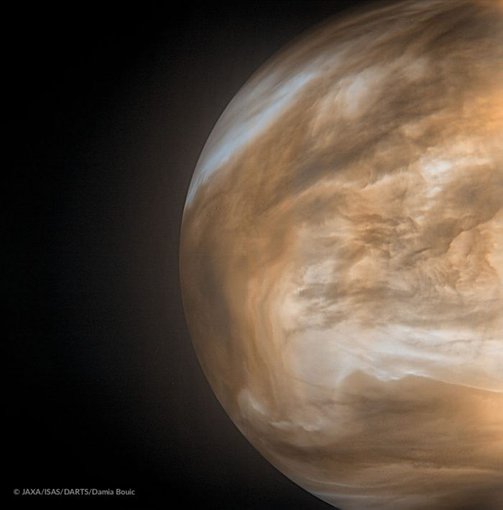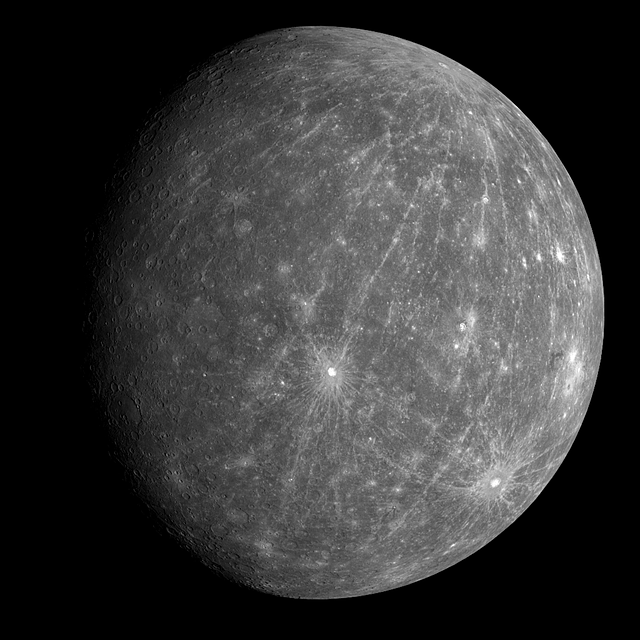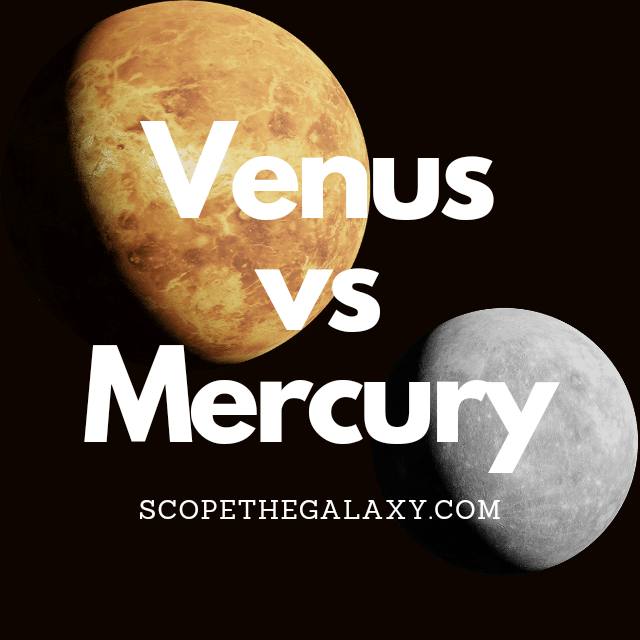*This post may contain affiliate links. This means we may make a commission if you purchase an item using one of our links*
The main differences between Venus and Mercury is that Venus is the 2nd closest planet to the Sun, is both the brightest and hottest planet in our solar system and has the thickest atmosphere amongst the terrestrial planets whereas Mercury is closest to the Sun, is the smallest planet and has an extremely thin atmosphere.
There are a variety of other differences between the two planets along with a few similarities so continue reading if you want a more thorough breakdown of the common features and differences between Venus and Mercury.
What Is The Planet Venus?
Table of Contents

Venus is the 2nd closest planet to the Sun and is often regarded as Earth’s sister planet. It’s very close to our Earth in size where its diameter is 12,104km. This is just over 600km less wide than our home planet.
Unlike all the planets further outside the Sun’s orbit, Venus has no moons orbiting it. The most probable reason for this is due to its closer proximity to it, which means that smaller objects orbit the Sun as opposed to Venus.
Venus is also the hottest planet in our solar system where its surface temperature is 475 degrees Celsius. This is due to a number of factors, like the thicker atmosphere, close proximity to Sun, the reasons for which have been explained in more detail here.
It’s core is hot too, similar to that of the ice giants and Earth, where it stands at 5,200 degrees Celsius.
As a result of this thicker atmosphere, Venus is also able to reflect a lot more of the light the Sun projects at it, making it both the hottest and brightness planet in our solar system. This is why for the longest time, and even till this day Venus is often referred to as the morning or evening star.
The thicker atmosphere is mostly compromised of carbon dioxide, and thick clouds of sulfuric acid. This does result sulfuric acid rain on the planets surface, which of course is very corrosive.
Being so close to the Sun also mean its orbital cycle is much shorter. It takes Venus 225 days to complete a full cycle, on the contrary a single day is actually longer than this where it takes around 243 days for a full rotation around its axis.
This is partially down to its distance from the Sun and the thick atmosphere surrounding this terrestrial planet. The axial tilt on Venus is also different from the other planets in our solar system where it is practically straight at 3 degrees.
All in all this is certainly one of the most interesting planets in our solar system and in many peoples eyes, could very well have supported life in the past based on how close its shape and size is to that of Earth.
What Is The Planet Mercury?

Mercury is the planet closest to our Sun and would fall under the terrestrial planet moniker. Out of the 8 main line planets Mercury is also the smallest, coming in at 4,879km.
This planet is known for having its fair share of craters, which is mostly down to its thinner non protective atmosphere that is unable to stop interstellar debris from striking its surface.
Despite its close proximity to the Sun, Mercury is not the hottest planet in our solar system but, it does come in second, just behind Venus. It’s surface temperature is around 430 degrees on the upper end with the average temperature around 167 degrees Celsius whereas its core is far hotter at around 1,600 – 3,000 degrees Celsius.
Due to it close proximity to our local star, Mercury is unable to sustain a moon around its orbit and even has a very unique rotation around the Sun where it has 3:2 orbital resonance with the Sun.
As for how long it takes for the planet to rotate around our yellow dwarf star, its the shortest time period of 88 days for obvious reasons, whilst a single day on the planet takes 58.65 Earth days to complete. Its axial tilt is only 2 degrees to the right, making it amongst the straightest planets in the solar system too.
How Are Venus And Mercury Similar?
Although there are many features that separate Venus and Mercury from each other, they still do have a few common features. These would include the following:
- Both have a hotter central core.
- Both are a spherical in shape.
- Both are terrestrial planets.
- Both have an atmosphere and a rocky surface.
- Both orbit the Sun in a circular pattern.
- Both have no moons orbiting them.
- Neither are tidally locked to the Sun.
- Both have no rings surrounding them.
Differences Between Venus And Mercury
As for the differences between the two, they include the below:
- Venus has the thickest atmosphere amongst the terrestrial planet whilst Mercury has the thinnest atmosphere.
- Mercury has the craters in our solar system per surface area for a normal planet where 743 have been counted (there’s a possibility for more) whereas Venus has around 1,000 craters that have been discovered.
- Venus is the hottest planet in our solar system where its surface temperature is around 475 degrees on average and Mercury is around 167 degrees on average.
- Venus has a hotter core which is around 5,200 degrees Celsius whilst Pluto’s core is around 1,600 – 3,200 degrees Celsius.
- Mercury is the closest planet to the Sun whilst Venus is the 2nd closest, Therefore, it takes Mercury 88 days to orbit the Sun and Venus 225 days.
- Venus has the longest day for any planet in our solar system where it takes it 243 days whilst Mercury completes a day in 58.65 days.
- Venus is much bigger than Mercury where it has a diameter of 12,104km whilst Mercury has a diameter of 4,879km.
- Venus has a multitude of volcanoes erupting on its surface whilst Mercury’s surface consists of a rocky terrain and sulfur.
- Mercury has an axial tilt of 2 degrees as opposed to Venus’ 3 degrees.
Summary
Mercury and Venus both have their fair share of similarities, from their terrestrial nature, their lack of moons and even their excess amount of surface craters however, they differ in more ways than they are similar.
This would include the differences in temperature, how Venus takes longer to orbit the Sun and has a longer day, is much bigger, has a far thicker atmosphere and more. All in all, both planets may be part of the same solar system but, differ in a variety of ways still.

